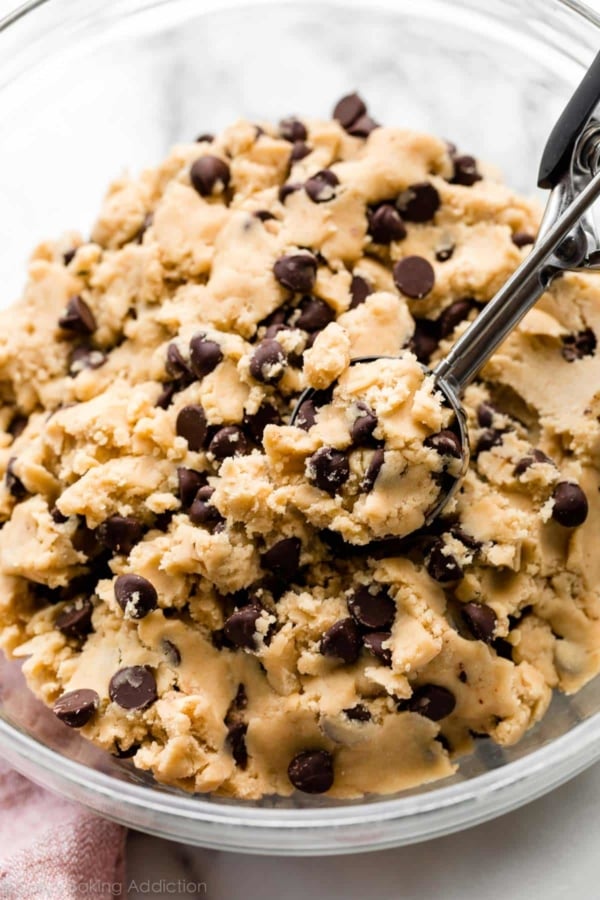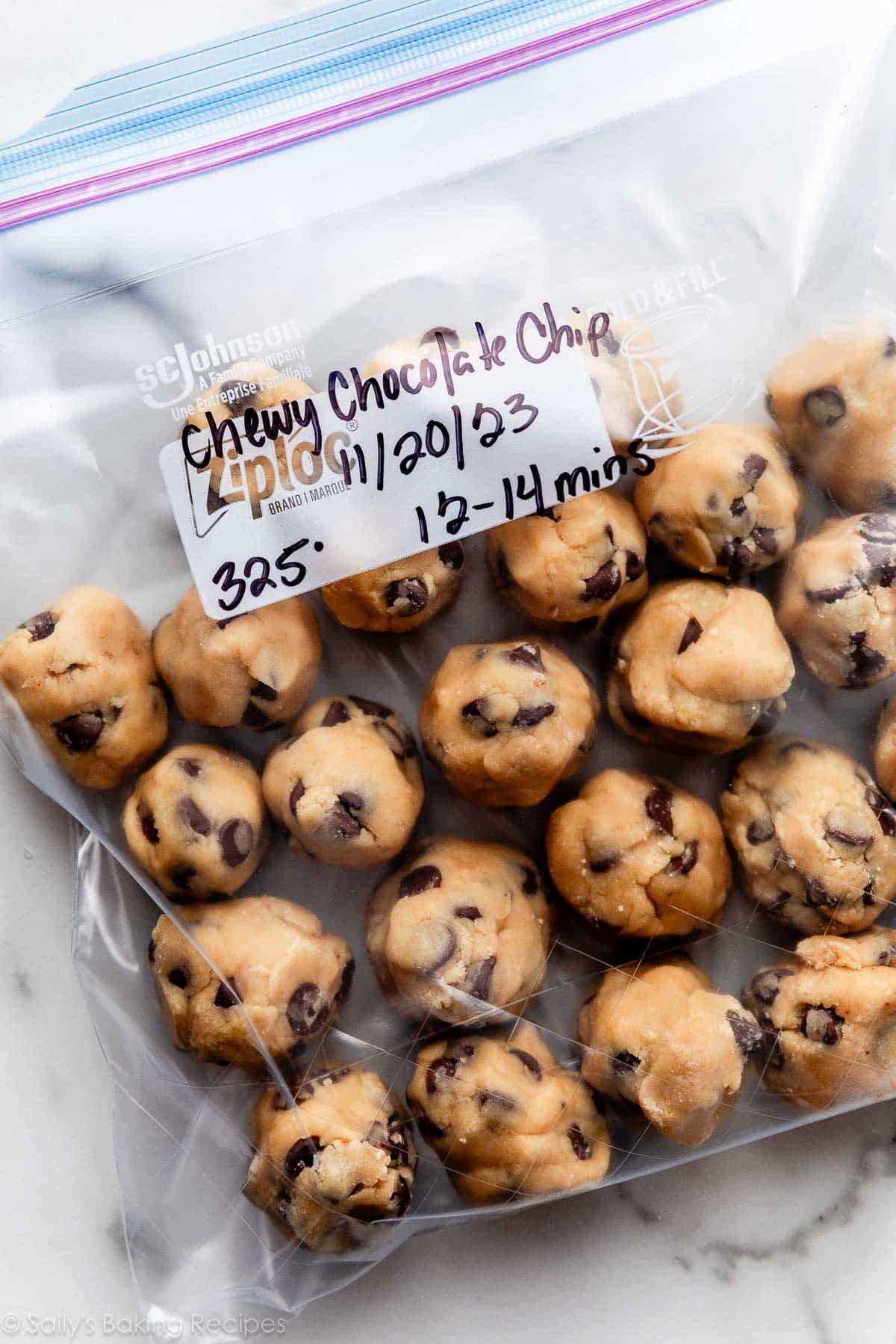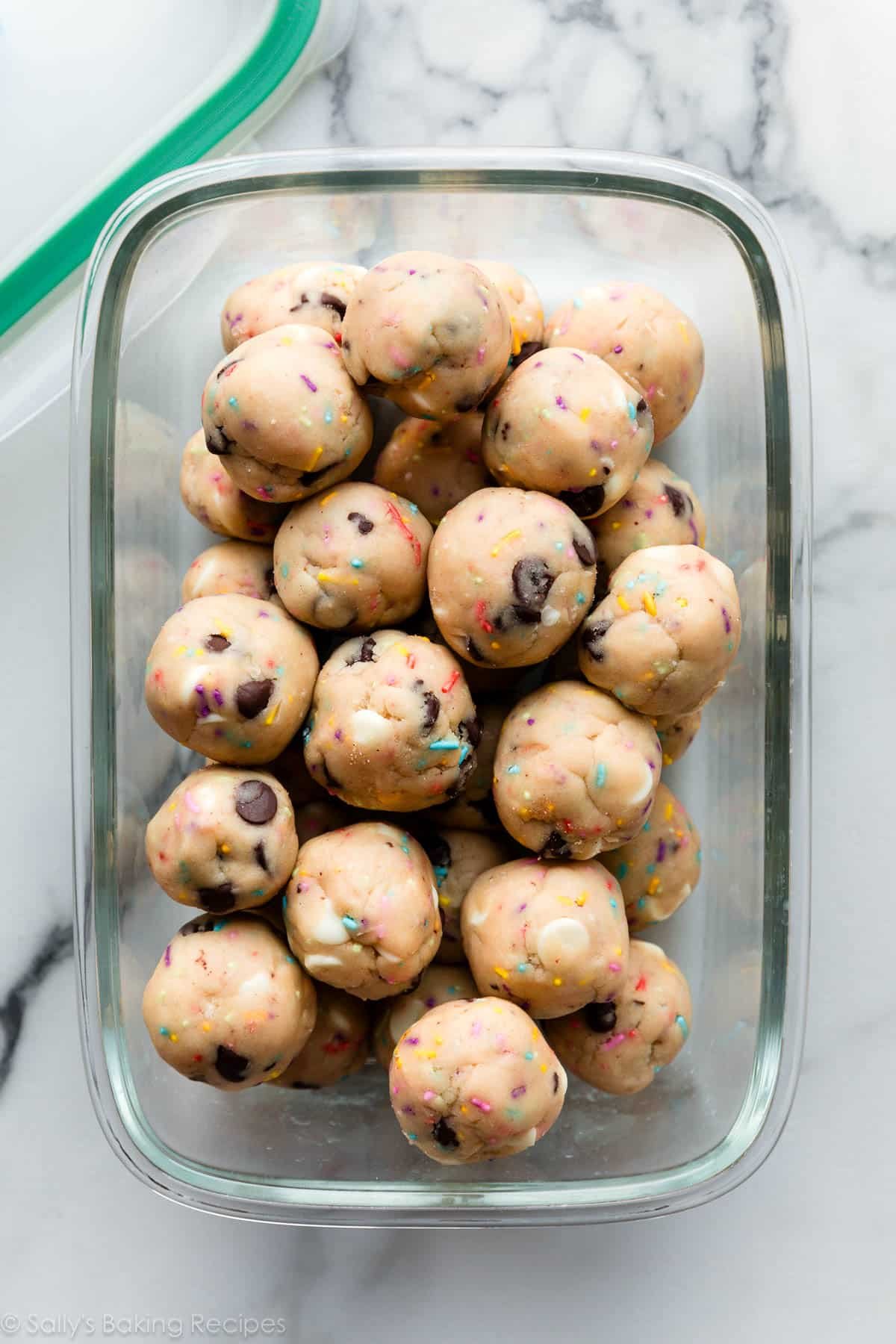Cookie dough freezes beautifully, and this is a great way to plan ahead for the holiday baking season, or so you can have warm, fresh cookies whenever that craving hits. Learn how to freeze cookie dough from this comprehensive post, which includes a video tutorial. I’ll show you the best ways to freeze different types of cookie dough, from drop cookies to cut-out cookies to slice-and-bake style.
Have you ever made cookie dough just to freeze it for later? Or freeze some cookie dough instead of baking the whole batch? I do both all the time, especially with these chocolate chip cookies.
It’s so convenient to have a stash of ready-to-bake homemade cookie dough on hand, in case you find yourself in need of a quick dessert at the last minute. Maybe new neighbors just moved in, a friend had a baby, or you forgot about the school bake sale until the morning of… frozen cookie dough comes to the rescue.
Make the dough when you have the time, and simply bake the cookies when you don’t!
This post is part of my Baking Tips category. Over the years, I’ve published dozens of articles and videos that aren’t only recipes, but baking success tips to help you gain confidence in the kitchen.

How to Freeze & Bake Drop Cookie Dough
“Drop cookies” refers to cookie doughs that you scoop and drop onto the baking sheet, like oatmeal raisin cookies. I include dough that you roll into balls in this category, because it, too, requires very little shaping—like double chocolate chip cookies and cake batter chocolate chip cookies.


Drop-style cookies take a few extra steps before freezing, but it’s worth it because the cookie dough can go straight from the freezer to the preheated oven for a treat that’s ready in about 10–15 minutes. Here’s how to do it:
- Chill the dough: If the cookie recipe you’re using says to chill the dough before scooping and rolling, you still need to take that step.
- Shape the cookies: After the cookie dough has chilled in the refrigerator, scoop and roll the cookie dough into balls (or shape into tall columns, like I recommend for these chewy chocolate chip cookies). Place them on a lined baking sheet or plate, making sure to keep them from touching each other.
- Chill the cookie dough balls: Cover the tray or plate and place in the refrigerator for 1 hour. This will set the cookie dough balls’ shape, and prevent them from sticking together in the freezer container.
- Transfer the cookie dough balls to a container or bag: Place the cold cookie dough balls into a freezer-friendly container. It’s OK if they’re touching each other now (since the shape has set).
- Label the bag or container with the recipe name, the date, baking temperature, and bake time (add an extra minute or two if baking from frozen), and place in the freezer.
- Freeze cookie dough for up to 3 months: Labeling with the date will help you determine by when the cookie dough should be baked.
- Bake the cookies: When you’re ready to bake, preheat the oven. Place the frozen cookie dough balls on a lined baking sheet, per your recipe’s instructions. Add an extra minute or two to the bake time, because the dough is frozen.
In photos: Make and refrigerate the dough, if the recipe calls for chilling the cookie dough. Then shape into balls per your recipe’s instructions. Refrigerate the shaped dough balls to set their shape:


Then place into a labeled bag, and freeze for up to 3 months:

4 Reasons Why You Should Freeze Cookie Dough
- Cookie dough freezes well for up to 3 months, so it’s a great way to get ahead for the holidays or other busy times.
- For drop cookies, you don’t need to wait for the dough to thaw—bake from frozen.
- You don’t have to bake the whole batch at once—you can bake just 1 or 2 when you’re craving a freshly baked, warm cookie.
- Having a stash of cookie dough in the freezer means you are always prepared for a dessert emergency.


Today I’m sharing with you my best tips for how to freeze, thaw, and bake cookie dough. Doesn’t sound revolutionary, but you won’t believe the confusion and mistakes one can make when it comes to freezing and baking cookie dough. I originally published this post back in 2015, and have learned a few more tricks since. Happy to share them today, along with a new video tutorial.
Should refrigerated cookie dough be brought to room temperature before baking?
Can You thaw cookie dough?
To thaw cookie dough in the refrigerator, remove your frozen dough from the freezer and place it inside. Most cookie doughs will require an overnight visit in the fridge to be adequately thawed and ready for baking (8 to 12 hours). Yes, I know this isn’t exactly fast or convenient, and it won’t work if you need to bake your cookie dough ASAP.
What is the recipe for making cookie dough?
There are many recipes, some healthy and most not. The recipe can vary according to your personal taste, but I’ll put a recipe here: Ingredients (20 servings) 1 whole egg 2 cups rolled oats 1/3 cup chopped nuts (walnuts, almonds, cashews, Brazil nuts, peanuts) 1/3 cup raisins (white and black) 1/3 cup chocolate chips 1/3 cup coconut oil 3/4 cup brown sugar 1 teaspoon vanilla essence 2 tablespoons cocoa powder 1 teaspoon powdered yeast Method of preparation 1. Mix all the ingredients until you get a homogeneous mass and it is no longer sticking to your hands. 2. Separate the dough into small portions with the help of a tablespoon, make balls and flatten them to form a disc. 3. Put them in the mold (no need to grease the mold) 4. Take to preheated oven at 150°C for approximately 15 minutes. 5. Remove from the oven and let it cool, so they will be firm and dry.
How do you thaw cookies before baking?
Simply preheat the oven to the instructed temperature, remove the number of cookies you need (or are craving), and bake! Thawing At Room Temperature: You can take out the number of cookies needed and let them thaw at room temperature for about 30 minutes. Bake as instructed.
Can you freeze cookies after thawing?
A: In general, it’s best to avoid refreezing cookies after they have been thawed. Each time you freeze and thaw food, including cookies, you risk changes in texture, moisture content, and potential loss of quality. Q: How Can I Prevent Freezer Burn?
